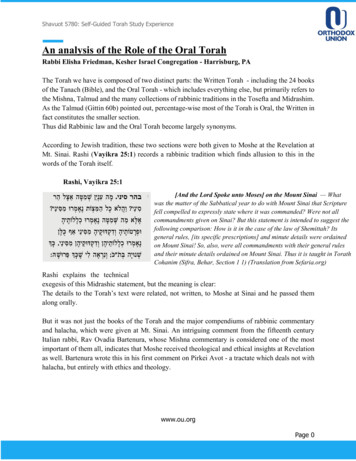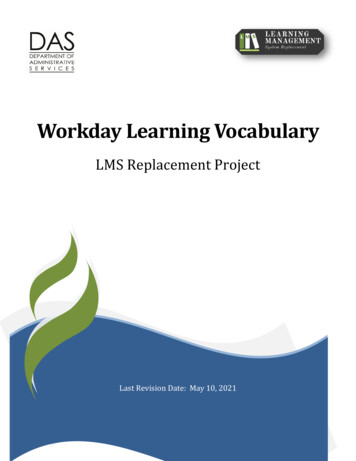
Transcription
Shavuot 5780: Self-Guided Torah Study ExperienceAn analysis of the Role of the Oral TorahRabbi Elisha Friedman, Kesher Israel Congregation - Harrisburg, PAThe Torah we have is composed of two distinct parts: the Written Torah - including the 24 booksof the Tanach (Bible), and the Oral Torah - which includes everything else, but primarily refers tothe Mishna, Talmud and the many collections of rabbinic traditions in the Tosefta and Midrashim.As the Talmud (Gittin 60b) pointed out, percentage-wise most of the Torah is Oral, the Written infact constitutes the smaller section.Thus did Rabbinic law and the Oral Torah become largely synonyms.According to Jewish tradition, these two sections were both given to Moshe at the Revelation atMt. Sinai. Rashi (Vayikra 25:1) records a rabbinic tradition which finds allusion to this in thewords of the Torah itself.Rashi, Vayikra 25:1[And the Lord Spoke unto Moses] on the Mount Sinai — Whatwas the matter of the Sabbatical year to do with Mount Sinai that Scripturefell compelled to expressly state where it was commanded? Were not allcommandments given on Sinai? But this statement is intended to suggest thefollowing comparison: How is it in the case of the law of Shemittah? Itsgeneral rules, [its specific prescriptions] and minute details were ordainedon Mount Sinai! So, also, were all commandments with their general rulesand their minute details ordained on Mount Sinai. Thus it is taught in TorathCohanim (Sifra, Behar, Section 1 1) (Translation from Sefaria.org)Rashi explains the technicalexegesis of this Midrashic statement, but the meaning is clear:The details to the Torah’s text were related, not written, to Moshe at Sinai and he passed themalong orally.But it was not just the books of the Torah and the major compendiums of rabbinic commentaryand halacha, which were given at Mt. Sinai. An intriguing comment from the fifteenth centuryItalian rabbi, Rav Ovadia Bartenura, whose Mishna commentary is considered one of the mostimportant of them all, indicates that Moshe received theological and ethical insights at Revelationas well. Bartenura wrote this in his first comment on Pirkei Avot - a tractate which deals not withhalacha, but entirely with ethics and theology.www.ou.orgPage 0
Shavuot 5780: Self-Guided Torah Study ExperienceBartenura, Avot 1.1Moshe received the Torah from Sinai: I say: Sincethis tractate is not founded on the exegesis ofcommandments from among the Torah’scommandments, like the rest of the tractates whichare in the Mishna, but is rather wholly morals andprinciples, and whereas the sages of the (other)nations of the world have also composed booksaccording to the fabrication of their hearts,concerning moral paths, how a person shouldbehave with his fellow; therefore, in this tractatethe tanna began "Moshe received Torah fromSinai," to tell you that the principles and moralswhich are in this tractate were not fabricated by thehearts of the Mishna’s sages; rather, they too werestated at Sinai.(Translation from Sefaria.org)The Oral Torah then consists of commentary on the Written Torah, halachic rulings and ethicalguidance.One of the great divides throughout our history has always been concerning this dogma. Manygroups have broken with the Rabbis over the years over the issue of whether the Oral Torah in factoriginated at Mt. Sinai or was it a creation of the Rabbis. The Karaites were the best-knownhistorical group who rejected the authority of the Oral Torah, and for centuries throughout themedieval period they were a dominant force in the Jewish world, although in the contemporaryworld their numbers and influence are hardly noticeable. Some historians believe the Karaitesdeveloped out of an earlier sect, the Sadducees, an ancient group who had defected from RabbinicJudaism in Mishnaic times. But this is not certain. Either way, the point remains the same: theKaraites were hardly the first Jews to question the Rabbinic tradition, and certainly not the lasteither. In the modern world, Conservative Judaism has inherited the mantle of those who questionthe authority of Rabbinic law.Of course, the Rabbis themselves did not claim that every law they formulated or every line in theTalmud was Divine in origin. There were many takanot, or decrees, which were unquestionablyRabbinic in origin, and still included in the Oral Torah. When the Rabbis disagreed, which was awww.ou.orgPage 1
Shavuot 5780: Self-Guided Torah Study Experiencecommon occurrence, it seems likely that not every opinion had originated at Sinai, although aminority school of thought argued precisely that. Even when the rabbis based their rulings on acareful reading of the Biblical text, a drasha, there is some debate amongst medieval authoritieswhether all of those instances originated with God or not.The important point for us is not whether every Rabbinic law or statement was given at Sinai, butthat some of it was given at Sinai. Even if the rabbis added to it, or disagreed over the exacttradition, traditional Judaism is clear that in addition to the written texts of Judaism, Moshe wasgiven a Divine supplement to the Written text, and that was the Oral Torah. In addition, God hadgiven the Rabbis the authority to add to the Torah as they saw fit in their generations, and so thattoo was included in the scope of the Oral Law.One of the great medieval Jewish thinkers and anti-Karaite polemicists, Yehuda Halevi (Sefer HaKuzari 3:35), pointed out how obvious this dogma becomes once you reflect on the matter.Sefer HaKuzari 3:35I further wish to be instructed on the question as to whatmakes an animal lawful for food; whether 'slaughtering'means cutting its throat or any other mode of killing; whykilling by gentiles makes the flesh unlawful; what is thedifference between slaughtering, skinning, and the rest of it.I should desire an explanation of the forbidden fat, seeingthat it lies in the stomach and entrails close to the lawful fat,as well as of the rules of cleansing the meat. Let them drawme the line between the fat which is lawful and that whichis not, inasmuch as there is no difference visible. Let themexplain to me where the tail of the sheep, which they declareunlawful, ends. One of them may possibly forbid the end ofthe tail alone, another the whole hind part. I desire anexplanation of the lawful and unlawful birds, excepting thecommon ones, such as the pigeon and turtle dove. How dothey know that the hen, goose, duck, and partridge are notunclean birds?www.ou.orgPage 2
Shavuot 5780: Self-Guided Torah Study ExperienceKuzari’s point here is straightforward. The Torah issues many commandments which provide noreal details as to how they are to be performed. In this example he wonders how to observe thelaws of kosher with only the scanty statements recorded in the Written Torah. One would have somany questions that they could not possibly perform the ritual properly. The same applies tomaking tefillin, building a Succah, the prohibited activities of Shabbat, and many other laws of theTorah which appear in brief, terse commands in the Torah, but which require pages of elucidationto perform properly. We are then left with the choice between either accusing God of irrationallygiving us a written work which was woefully inadequate for practical purposes or acknowledgingthere must have been a commentary which came together with the Written text.This proof points to the existence of a commentary but does not resolve the question of why Godset it up this way. Could not God, in His infinite genius, have figured out a way to give the Torahperfectly complete, so that it would be a self-contained document and not require any oralcommentary or elaboration? In explanation of this, many approaches have been offered. But mostof all, we should not make the mistake of thinking that God gave an Oral Torah out of weakness.In fact the halacha originally was that one was not permitted to write down the Oral Law (Gittin60b). It was by design, not accident or imperfection, that God introduced an oral component to theTorah, and this has much to teach us about the essential nature of Torah study.If we were to choose one approach to reflect on to explain why the Oral Torah is of centralimportance, I suggest the one offered by Rav Samson Raphael Hirsch (Rav S.R. HirschCommentary on the Torah, Shemot 34:27 and earlier commentaries):God did not want people to study Torah through books, but from a human being. As theproverb quoted by Kuzari (2:72) states: “From the mouths of scholars, but not from themouth of books.” The Torah is not for autodidacts, it is geared at those who seek to formanother chain in the historical transmission of the tradition from generation to generation,connecting us all directly back to the moment of Revelation at Sinai. One approach toguard against self-study is for it not to be recorded, to force the student to seek out a rebbe(Torah teacher) in order to be initiated.This is a radically new way to think about Torah study. In our world where this model has fallenapart, everything has been written down and many people are Torah scholars through their ownbook study, it is hard to imagine the alternative. When we think of Torah scholars we imaginelarge volumes of print Hebrew works, with someone studying for hours a day. Our impression ofTorah study and Torah greatness is completely intertwined with the image of immersion in booksand printed pages.To be a Torah giant in the age of the Oral Law one had to know not books, but people, one spenttheir day not with printed pages, but with living, breathing mentors and colleagues. The rebbewww.ou.orgPage 3
Shavuot 5780: Self-Guided Torah Study Experiencepassed on to his students not only information and modes of analysis, but also how to be a humanbeing, how to be a mensch. And the rebbe had discretion over who he taught, so a student whoasked for only facts but was not interested in ethical guidance, would not be taught either. The ideaof a Torah scholar who was not also a mensch and a fully developed social personality would havebeen foreign to them.It was this ideal which allowed Rav Chaim of Volozhin, the father of the modern yeshiva systemwhich stressed the near constant study of books, to interpret the Mishna (Avot 6:6) which statesthat Torah must be studied “with a listening ear” to mean that Torah is better studied through audiothan reading books. “Because the sense of hearing [and] what you hear from a person, willaccomplish more than what you read in books.” (Ruach Chaim Commentary on Avot) Of coursealmost the entirety of the yeshiva curriculum is based on reading printed Talmud andcommentaries, not listening. But Rav Chaim understood that was not the ideal, the printed volumeswere a concession. Ideally, we study Torah from another human being by listening.Had the ideal continued we would think of Torah scholars as some of the most socially advancedhumans, spending their days and nights immersed in relationship building with teachers of Torah,imbibing their living tradition. But alas, the original model was not to be. As with so much lostthroughout Jewish history, it was primarily anti-Semitism at fault. When the Romans occupiedIsrael, it became apparent that the Oral Torah would not survive those difficult times, and so theleader of Israel at the time, Rabbi Judah Hanasi (the Prince) committed the Mishna to writing(Rashi, Baba Metzia 33b, Rambam, Introduction to Mishneh Torah). The Mishna was notthorough, but rather contained broad legal principles, and so some centuries later the rest wasrecorded in the Talmud.From now on the Oral Torah would all be written down, available for anyone willing to committhe time and energy to study it. Of course, we still encourage people to seek a rebbe as much aspossible, but the halacha recognizes that practically this rarely happens. The books are now ourprimary teachers, say modern halachic authorities (Lechem Mishna, Laws of Torah Study 5:4,Pitchei Teshuva, Yoreh Deah 242:3, and others). Some things have improved, such as the easeof access to the Oral Law, which is now readily available, and growing even more accessiblethrough translations and commentaries and online classes. And, by extension, there are now morepeople than ever studying it, so there have been improvements.In any case it is totally different.www.ou.orgPage 4
The Torah we have is composed of two distinct parts: the Written Torah - including the 24 books of the Tanach (Bible), and the Oral Torah - which includes everything else, but primarily refers to the Mishna, Talmud and the many collections of rabbinic traditions in the Tosefta and Midrashim.











